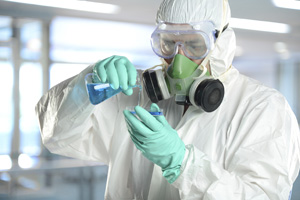

Ebola in the Workplace
As this issue went to press, only a few confirmed cases of Ebola existed in the U.S. What happens if it spreads?
At this point, the U.S. Centers for Disease Control seems confident in the ability of the country’s health system to contain and prevent the spread of the disease here. Health insurers, which would have to bear much of the cost of an Ebola epidemic, are watching the situation but do not seem overly concerned.
Exposure to the Ebola virus can cause Ebola hemorrhagic fever, or EHF. This condition is usually marked by fever, muscle pain, headache and sore throat. The illness progression includes nausea, vomiting, diarrhea and impaired organ function. In some cases, rash, internal and/or external bleeding, and death may occur.
Workers performing tasks involving close contact with symptomatic individuals with EHF or in environments contaminated or reasonably anticipated to be contaminated with infectious body fluids are at risk of exposure. These workers may include workers in the healthcare, mortuary and death care, airline, and other travel service industries.
Occupational safety and health law requires employers to provide their employees with working conditions that are free of known dangers. Yet in an October survey by allnurses.com, 74 percent of nurses surveyed said they did not feel prepared to deal with an Ebola outbreak and feared for their safety. The OSHA law also prohibits employers from retaliating against employees for exercising their rights under the law (including the right to raise a health and safety concern or report an injury).
In a Wall Street Journal article (October 14, 2014), Stanford Wilson, an Atlanta-based employment lawyer, advised hospitals against forcing employees to work with Ebola patients. He said hospitals could face lawsuits or federal complaints if they did. He also advised against giving hazard pay to workers potentially exposed to the virus, saying that could cause problems for employers. It can create expectations of hazard pay when other risky situations arise.
Employers whose workers may be exposed to the Ebola virus would likely need to comply with provisions from a combination of OSHA standards in order to implement a comprehensive worker protection program.
OSHA’s Bloodborne Pathogens standard covers exposure to Ebola virus, as it is transmitted by blood or other potentially infectious materials as defined in the standard. In situations where workers may be exposed to bioaerosols containing Ebola virus, employers must also follow OSHA’s Respiratory Protection standard.
Other elements of infection control for Ebola, including a number of precautions for contact-transmissible diseases, are covered under OSHA’s Personal Protective Equipment (PPE) standard (29 CFR 1910.132) and the General Duty Clause of the Occupational Safety and Health (OSH) Act of 1970, which requires employers to keep their workplace free of recognized hazards that can cause death or serious harm to workers.
Employers may also be required to follow these and other standards to protect their workers from exposure to chemicals used for cleaning and disinfection. Depending on the specific chemicals used, you may require different or additional personal protective equipment.
In an Ebola outbreak, scientists believe that the first patient becomes infected through contact with an infected animal, such as a fruit bat or primate (apes and monkeys.) Person-to-person transmission follows and can lead to large numbers of affected people.
When an infection occurs in humans, the virus can spread to others in several ways. Ebola is spread through direct contact (through broken skin or mucous membranes in, for example, the eyes, nose, or mouth) with:
- blood or body fluids (including urine, saliva, sweat, feces, vomit, breast milk, and semen) of a person sick with Ebola
- objects (such as needles and syringes) that have been contaminated with the virus
- infected fruit bats or primates.
If you have employees who travel to or are in an area affected by an Ebola outbreak, make sure they do the following:
- Practice careful hygiene. For example, wash hands with soap and water or an alcohol-based hand sanitizer and avoid contact with blood and body fluids.
- Do not handle items that may have come in contact with an infected person’s blood or body fluids (such as clothes, bedding, needles, and medical equipment).
- Avoid funeral or burial rituals that require handling the body of someone who has died from Ebola.
- Avoid contact with bats and nonhuman primates or blood, fluids and raw meat prepared from these animals.
- Avoid hospitals in West Africa where Ebola patients are being treated. The U.S. embassy or consulate is often able to provide advice on facilities.
- After they return, employees should monitor their health for 21 days and seek medical care immediately if they develop symptoms of Ebola.
For more information on infection control and other safety and risk management programs, please contact us.
The information presented and conclusions within are based upon our best judgment and analysis. It is not guaranteed information and does not necessarily reflect all available data. Web addresses are current at time of publication but subject to change. SmartsPro Marketing and The Insurance 411 do not engage in the solicitation, sale or management of securities or investments, nor does it make any recommendations on securities or investments. This material may not be quoted or reproduced in any form without publisher’s permission. All rights reserved. ©2014 The Insurance 411. Tel. 877-762-7877. www.theinsurance411.com